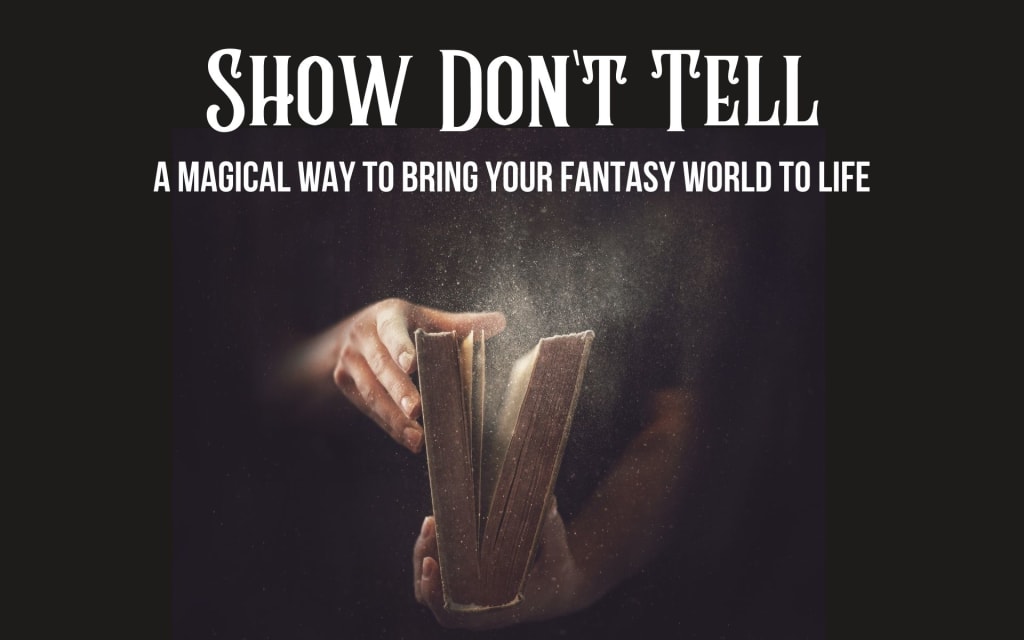Writing Basics for Fantasy Authors
Show, Don't Tell

One of the most popular bits of advice for aspiring writers is: Show, don’t tell. It’s the first thing taught in any creative writing class, but what does it mean in regards to writing paranormal and fantasy fiction?
This particular technique has been employed by fiction writers for ages, though it wasn’t mentioned as part of the craft until Percey Lubbock wrote about it in his 1921 book, The Craft of Fiction.
“The art of fiction does not begin until the novelist thinks of his story as a matter to be shown, to be so exhibited that it will tell itself.”
Excerpt From: Percy Lubbock. “The Craft of Fiction.” Apple Books.
In other words, as a writer, you want to pull your reader inside the story. It’s important to present the unique fantasy world you design as a tangible experience for a reader to sense and feel.
A famous example of this technique comes from the Russian playwright Anton Chekhov who wrote in a letter to his brother,
"In descriptions of Nature one must seize on small details, grouping them so that when the reader closes his eyes he gets a picture. For instance, you’ll have a moonlit night if you write that on the mill dam a piece of glass from a broken bottle glittered like a bright little star, and that the black shadow of a dog or a wolf rolled past like a ball."
For most readers, it’s possible to experience this scene Chekhov mentions like a mental picture inside the mind. Using specific active words like glittered and rolled, along with comparisons to common things such as a little star and a shadow put a reader inside the story with tangible details.
As a writer of paranormal or fantasy fiction, you’re an artist. It’s your job to think of the most specific way to evoke a reader’s senses, much like a painter brings a world to life in their paintings. It’s also the most difficult thing to do, as what’s vivid inside your own mind never comes out on the page the way you want it to! But, that’s what terrible first drafts are for. . . .
Once you get your story out onto the page and have a more objective point of view, editing for these sensory details is much easier to accomplish. Almost every writer tells in the first draft. That’s totally normal. You can’t fix what isn’t on the page, so get that story down first.
As you go on to revise, try to make note of passive or filter words such as
- Thinks
- Realizes
- Understands
- Wondered
- Seemed
- Knows
- Looks
- Felt
- Was

These are just a few of the most common words we use as writers — and we all use them — that can be revised to show our readers the world in our minds rather than simply tell them about it.
Sometimes it helps to consider the senses available to your character. This is where the extra fun part of being a supernatural or fantasy author comes into play. In your special world, rules that apply to our mundane existence as humans can be enhanced or removed based on any special abilities your character may have, or lack, and this can become an interesting part of your story.
For example, if your character is a medium or a witch, think of what special ways they might interpret the world around them. Does your character see auras?
If so, perhaps you could change a telling sentence like, "The fairy was angry."
Try adding more detail, such as, "The vibrant purple haze around the fairy darkened into black, like a storm cloud."
If your story includes shifters, what do they sound like? Instead of merely growling, a low, menacing rumble might emanate from behind razor-sharp canines.
A vampire wouldn’t just taste blood. They’d savor the metallic flavor mixed with a hint of strawberries that’s unique to their particular victim.
Your main character could touch some slime and feel disgusted. Or instead, they might place their hand in a warm puddle of viscous fluid that sticks to their palm, and sends their heart racing.
These types of scenarios allow you the opportunity as a fantasy writer to play with your techniques and how you build your world and magic systems. With plenty of practice, you’ll begin to develop that ever elusive voice, or style that’s unique to you and your own series. Using this way of storytelling will also help you hone your characters, and immerse readers in your exciting world of magic and fantasy.
As always, there are no hard and fast rules to any form of writing. If you find this useful, great! If not, let it go and move on to something that works for you. Be sure to read a lot in your genre so you can get a feel for what you find enjoyable as a reader, and use those strategies as you develop your personal craft.
For further reading check out, Chuck Palahniuk's essay "Nuts and Bolts: Thought Verbs."






Comments
There are no comments for this story
Be the first to respond and start the conversation.